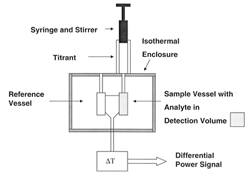|
|
Vol.
30 No. 6
November-December 2008
Recommendations on Measurement and Analysis of Results Obtained on Biological Substances Using Isothermal Titration Calorimetry (IUPAC Technical Report)
Frederick P. Schwarz, Timm Reinisch, Hans-Jürgen Hinz, and Avadhesha Surolia
Pure and Applied Chemistry, 2008
Vol. 80, No. 9, pp. 2025–2040
doi:10.1351/pac200880092025
Isothermal titration calorimetry (ITC) is widely used to determine the thermodynamics of biological interactions, including protein-protein, small molecule-protein, protein-DNA, small molecule-DNA, and antigen–antibody interactions. An ITC measurement consists of monitoring the transfer of heat between an analyte solution in a sample vessel and a reference solution in a reference vessel upon injection of a small aliquot of titrant solution into the sample vessel at a fixed ITC operating temperature. A binding isotherm is generated from the heat-transferred-per-injection data. Values for the binding constants, the apparent binding enthalpies, and the apparent ratio of the amount of titrant to analyte for the binding reaction are then determined from fits of a binding model (whether it is a single site, identical multi-site, or an interacting multi-site binding model) to the binding isotherm.
 |
| Basic ITC instrument, consisting of a sample vessel containing the analyte solution and a vessel containing a reference solution (e.g., buffer solution) within an isothermal enclosure. |
Prior to the fitting procedure, corrections should be made for contributions from extraneous heat of mixing determined separately from injections of the titrant into just the dialysate/buffer solution. Ultra-high binding constants, which cannot be directly determined from an ITC measurement, can be determined by a displacement ITC method where injections of the tight-binding titrant into a solution of a weaker-binding titrant-analyte complex displaces the weaker-binding titrant from the complex. The Michaelis and catalytic constants can be determined for an enzyme reaction from injections of a substrate or enzyme titrant into an enzyme or substrate analyte solution. This article suggests several binding reactions to use to check the operating performance of the ITC. The reporting of ITC results must be specific with regard to the composition of the titrant and the analyte solutions, the temperature, and the model used in the analysis.
http://dx.doi.org/10.1351/pac200880092025
Page
last modified 26 November 2008.
Copyright © 2003-2008 International Union of Pure and
Applied Chemistry.
Questions regarding the website, please contact [email protected] |